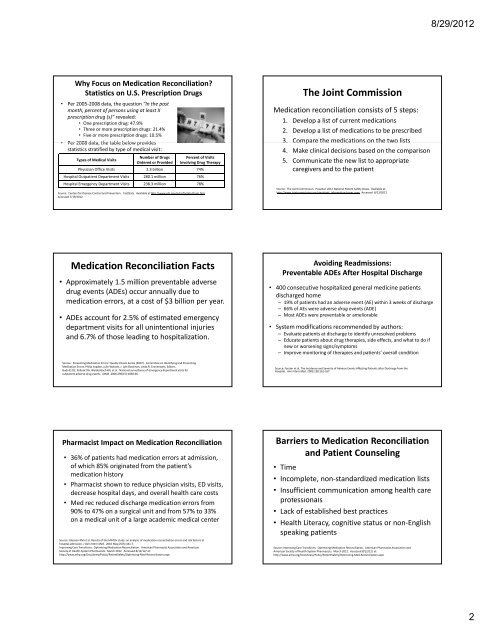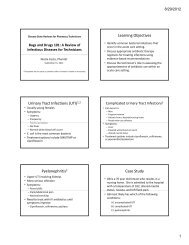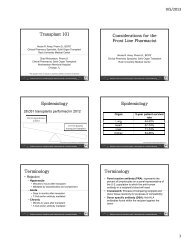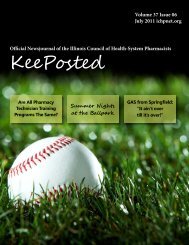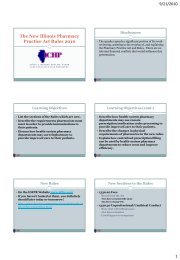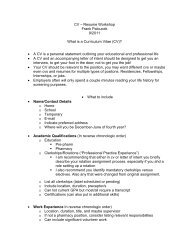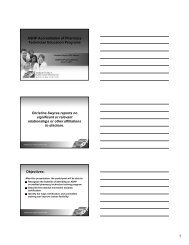Presentation Outline ICHP Annual Meeting September 13-15
Presentation Outline ICHP Annual Meeting September 13-15
Presentation Outline ICHP Annual Meeting September 13-15
You also want an ePaper? Increase the reach of your titles
YUMPU automatically turns print PDFs into web optimized ePapers that Google loves.
Why Focus on Medication Reconciliation?<br />
Statistics on U.S. Prescription Drugs<br />
• Per 2005‐2008 data, the question “In the past<br />
month, percent of persons using at least X<br />
prescription drug (s)” revealed:<br />
• One prescription drug: 47.9%<br />
• Three or more prescription drugs: 21.4%<br />
• Five or more prescription drugs: 10.5%<br />
• Per 2008 data, data the table below provides<br />
statistics stratified by type of medical visit:<br />
Types of Medical Visits<br />
Number of Drugs<br />
Ordered or Provided<br />
Percent of Visits<br />
Involving Drug Therapy<br />
Physician Office Visits 2.3 billion 74%<br />
Hospital Outpatient Department Visits 280.1 million 76%<br />
Hospital Emergency Department Visits 238.3 million 78%<br />
Source: Centers for Disease Control and Prevention. FastStats. Available at http://www.cdc.gov/nchs/fastats/drugs.htm.<br />
Accessed 7/19/2012.<br />
Medication Reconciliation Facts<br />
• Approximately 1.5 million preventable adverse<br />
drug events (ADEs) occur annually due to<br />
medication errors, at a cost of $3 billion per year.<br />
• ADEs account for 2.5% of estimated emergency<br />
department visits for all unintentional injuries<br />
and 6.7% of those leading to hospitalization.<br />
Source: Preventing Medication Errors: Quality Chasm Series (2007). Committee on Identifying and Preventing<br />
Medication Errors, Philip Aspden, Julie Wolcott, J. Lyle Bootman, Linda R. Cronenwett, Editors.<br />
Budnitz DS, Pollock DA, Weidenbach KN, et al. National surveillance of emergency department visits for<br />
outpatient adverse drug events. JAMA .2006;296(<strong>15</strong>):1858‐66.<br />
Pharmacist Impact on Medication Reconciliation<br />
• 36% of patients had medication errors at admission,<br />
of which 85% originated from the patient’s<br />
medication history<br />
• Pharmacist shown to reduce physician visits, ED visits,<br />
decrease hospital days, and overall health care costs<br />
• Med rec reduced discharge medication errors from<br />
90% to 47% on a surgical unit and from 57% to 33%<br />
on a medical unit of a large academic medical center<br />
Source: Gleason KM et al. Results of the MATCH study: an analysis of medication reconciliation errors and risk factors at<br />
hospital admission. J Gen Intern Med. 2010 May;25(5):441‐7.<br />
Improving Care Transitions: Optimizing Medication Reconciliation. American Pharmacist Association and American<br />
Society of Health‐System Pharmacists. March 2012. Accessed 8/12/12/ at:<br />
http://www.ashp.org/DocLibrary/Policy/PatientSafety/Optimizing‐Med‐Reconciliation.aspx<br />
The Joint Commission<br />
Medication reconciliation consists of 5 steps:<br />
1. Develop a list of current medications<br />
2. Develop a list of medications to be prescribed<br />
3. 3 Compare Co pa e tthe emedications ed cat o s on o the t et two olists sts<br />
4. Make clinical decisions based on the comparison<br />
5. Communicate the new list to appropriate<br />
caregivers and to the patient<br />
Source: The Joint Commission. Hospital: 2012 National Patient Safety Goals. Available at:<br />
http://www.jointcommission.org/standards_information/npsgs.aspx. Accessed 8/<strong>13</strong>/2012<br />
Avoiding Readmissions:<br />
Preventable ADEs After Hospital Discharge<br />
• 400 consecutive hospitalized general medicine patients<br />
discharged home<br />
– 19% of patients had an adverse event (AE) within 3 weeks of discharge<br />
– 66% of AEs were adverse drug events (ADE)<br />
– Most ADEs were preventable or ameliorable<br />
• System modifications recommended by authors:<br />
– Evaluate patients at discharge to identify unresolved problems<br />
– Educate patients about drug therapies, side effects, and what to do if<br />
new or worsening signs/symptoms<br />
– Improve monitoring of therapies and patients’ overall condition<br />
Source: Forster et al. The Incidence and Severity of Adverse Events Affecting Patients after Discharge from the<br />
Hospital. Ann Intern Med. 2003;<strong>13</strong>8:161‐167.<br />
Barriers to Medication Reconciliation<br />
and Patient Counseling<br />
• Time<br />
• Incomplete, non‐standardized medication lists<br />
• Insufficient communication among health care<br />
professionals f i l<br />
• Lack of established best practices<br />
• Health Literacy, cognitive status or non‐English<br />
speaking patients<br />
Source: Improving Care Transitions: Optimizing Medication Reconciliation. American Pharmacist Association and<br />
American Society of Health‐System Pharmacists. March 2012. Accessed 8/12/12/ at:<br />
http://www.ashp.org/DocLibrary/Policy/PatientSafety/Optimizing‐Med‐Reconciliation.aspx<br />
8/29/2012<br />
2


